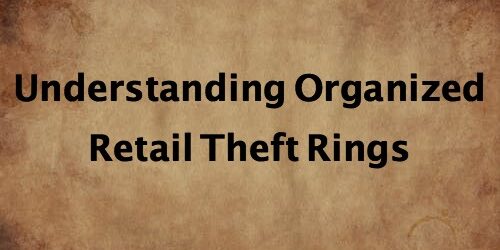Organized Retail Theft Rings Can Strike at Any Store in Any Place
Shoplifters can be found everywhere: walking through the shops at the mall, supermarkets, and even working in a small-town boutique store. But contrary to what many people assume, retail theft is more than a teenager swiping a chocolate bar or purse from the store. This is called an organized retail crime (ORC).
According to the National Retail Federation (NRF), organized theft crimes cost retailers $703,320 per $1 billion in sales. These crime groups cause stock shrinkage. So, if you are a retail store owner, it is crucial to have a basic understanding of what organized theft rings are, who can be a target, and what you can do to help combat your store falling victim.

First, What Exactly Is Organized Retail Theft?
What constitutes an ORC varies, but essentially, organized retail theft rings are professional shoplifters who steal retail goods to resell for profit or dispose of the goods. But mostly, for profit. They steal merchandise that’s beyond a person’s consumption and can wipe a store clean of thousands of dollars worth of inventory in a single hit. Some crime ring members-only target stores within their community, whereas others travel city to city and even state to state. There have been some instances where employees are involved in theft rings. We will discuss this later
According to the Congressional Act Service, there are two roles that individuals in these rings may play: “the booster” or “the fence.” Boosters are the insiders stealing the merchandise in the stores or supply chain. The fences pay the boosters for the illegally obtained items and resell the products to unknowing consumers.
Retail Items That Are Often Targeted
The most straightforward answer is that organized retail theft rings are people looking for a quick way to make money. Whether this means nabbing high-value merchandise or ones that are easily accessible to consumers, almost any retail store can become a target for an ORC. Many items have been reported to be targeted for theft. A few common items include:
- High demand items/brands
- High-end products, i.e., designer purses
- Electronics / printing products
- Beauty supplies
- Baby formula
- Cigarettes
- OTC medication
Recognizing Organized Theft Rings
Unfortunately, there are not always concrete signs of an organized theft ring invading your store until it is too late. The techniques used by these criminals are diverse – some theft rings operate at a simpler scale (distracting employees while the others steal the items). In contrast, others use technology or steal products through the supply chain. There are so many different tactics; it would be an entirely different post to describe each.
Employees Involved in ORC
Although ORC’s are generally considered external losses for retailers, they can also be internal losses. There have also been instances where the boosters (retail crime ring members that are stealing the items) were either employees of the store or bribed store employees to help them commit theft. Disabling alarms, blocking cameras, and leaving restricted access doors unlocked are signs of employee collusion with ORC.

How You Can Help Combat Organized Theft Rings
Although there is no way to prevent shoplifting in stores entirely, there are steps you can take to minimize the risk. Similar to combating ordinary shoplifting, these solutions can help reduce the risk of falling victim to being a target for an organized theft hit:
- Employee background checks
- Educating employees on common shoplifting tactics
- Train employees on de-escalation techniques
- Use only secure passwords to a business account
- Use video recording security systems
- Invest in a point of sale (POS) system
- Lock up high value and high demand items
Be aware that professional shoplifters a part of an organized theft ring can be armed and dangerous. According to Loss Prevention Media, the retail industry is one of the most common industries that experience workplace violence. Do not encourage employees to confront a retail theft ring on their own. Again, these are not amateur shoplifters.
If Your Store Has Become a Target for an Organized Crime Ring Hit
In 2018, the National Retail Foundation found that 94 percent of the surveyed retailers claimed to be victims of an ORC hit. This issue continues to happen and occurs almost every day across the country. If you believe your store has fallen victim to an ORC, be sure to contact law enforcement right away. Most ORC’s are handled by state law enforcement, and depending on the magnitude, federal law enforcement may be called to investigate. However, this does not often happen right away or as often.
For an in-depth investigation of the incident or to conduct background checks of employees, private investigators like us can help. We are licensed and have over 20 years of experience to provide commercial businesses with the answers they need regarding organized retail crimes. For a free and confidential consultation, contact our investigation firm today.








2 Comments